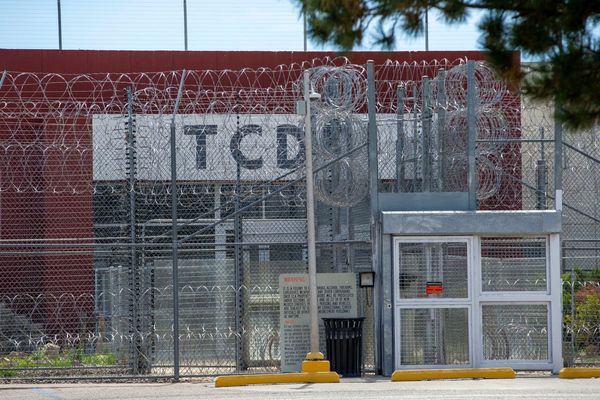
Peter Dutton is promising power bills will be 44% cheaper under his $331bn nuclear energy plan, but the modelling relies on demand not increasing as much as the government expects, despite the growing popularity of electric vehicles and energy-hungry technologies.
Dutton claimed on Friday his plan to introduce nuclear energy in Australia would “keep the lights on” at a lower cost than the Labor government’s renewables-reliant transition.
“This is a plan which will underpin the economic success of our country for the next century,” Dutton said in Brisbane on Friday.
“This will make electricity reliable. It will make it more consistent. It will make it cheaper for Australians and it will help us decarbonise as a trading economy – as we must.”
Dutton also foreshadowed immediate energy relief if he won next year’s election as he presented the Frontier Economics modelling on the plan to establish nuclear reactors at seven sites across Australia.
“It’s incredibly important people get help now, and we’re determined to do that,” he said.
The Coalition’s modelling suggests its nuclear plan would cost $331bn over 25 years. The opposition argues that is $263bn less than Labor’s renewables-transition plan to deliver Australia to net zero emissions by 2050. It presents two models with different emissions levels and suggests the Coalition’s plan is cheaper than Labor’s under both scenarios.
However, the modelling assumes demand for electricity would not increase as much as the government expects, despite the increasing use of energy-hungry artificial intelligence and the growing popularity of electric vehicles.
The climate change and energy minister, Chris Bowen, called this a “fatal error” and the plan “a complete farce”.
“It is a dangerous error because it is risky,” Bowen said on Friday. “It runs the risk of leaving Australians short of the energy they need.”
Bowen told the ABC the Coalition was asking people to believe it could introduce the most expensive form of energy “and it will end up being cheaper”.
“It won’t pass the pub test, it won’t pass the sniff test, because we know it is just a fantasy.”
The opposition’s energy spokesperson, Ted O’Brien, said the Coalition believed the government’s demand profile was “too high”.
“We believe, in fact, it could never be achieved, because as Labor continues to build out this fantastical program that it has, prices are only going to keep going through the roof,” O’Brien said.
“Businesses won’t even be here to use the electricity they suggest is going to be used.”
O’Brien accused the government of forcing people to switch to electric vehicles and confirmed the modelling was based on a much lower take-up rate.
It also assumes that locating nuclear power plants at retiring coal-plant sites reduces the new transmission infrastructure required and that laws could be changed across the country to overturn current bans on nuclear energy.
Under the Coalition’s plan, nuclear energy would account for 38% of Australia’s energy needs by 2050, with renewables covering 54% and the final 8% coming from a combination of storage and gas. The Albanese government’s policy is to get to 82% renewables by 2030.
Dutton argues his plan would be 44% cheaper over 25 years than Labor’s plan to transition to a system substantially reliant on renewable energy.
“We have looked at the mix, and the mix will be about how we achieve that cost reduction,” Dutton said. “And 44% cheaper than Labor’s power prices over the course of decades ahead, I think, will be an incredibly significant difference between the two parties.”
The modelling does not compare like with like, however. The 44% reduction in costs is based on comparing two different scenarios for developing the grid, rather than the same scenario with and without nuclear. Labor’s preferred scenario, for example, sees 45% greater electricity demand than the Coalition’s.
In a preliminary report published last month, Frontier put the cost of Labor’s transition plan at about $600bn.
Bowen told reporters on Friday there were two further “fatal errors” in the Coalition’s modelling. He noted it assumed that introducing nuclear energy would cost $30 a megawatt hour when the CSIRO and the government regulator, Aemo, have said it would be more like $145 to $238.
The energy minister also pointed to the Coalition’s accusation that the government would “over-build” infrastructure and its claim that nuclear power would need fewer transmission lines.
“If they are to be taken seriously, they need to outline exactly what transmission lines they would cancel,” Bowen said.
New research from the CSIRO, published this week, suggests nuclear energy would cost twice as much as an energy grid dominated by renewables with firming support.
The Frontier modelling assumes the first nuclear power plant could be operating by 2036.
Many experts, including the CSIRO, have dismissed the Coalition’s assumption that a large-scale nuclear reactor could be generating electricity by then.
The CSIRO has said it would take a minimum of 15 years for Australia to establish the necessary legal and regulatory functions for nuclear and then finance, commission and build a working reactor.
Nicki Hutley, an economist with the Climate Council, said the Coalition was misleading Australians regarding the true cost of nuclear power.
“Nuclear doesn’t add up for Australia,” Hutley said. “The CSIRO tells us that nuclear energy will cost twice as much as renewables and the risks of further budget and bill blowouts are simply not worth it.
“International experience has proven that nuclear is a financial black hole, with the average project costing more than double its original estimate.”
The Minerals Council of Australia welcomed the Coalition modelling.
“We cannot afford to wait any longer to kickstart the work on developing a civilian nuclear energy option,” the council said in a statement. “The time to act is now —every delay risks missing out on clean, reliable and affordable energy that Australians urgently need for the future.”
Under Labor’s plan, almost all coal-fired power is due to leave the system within 10 years. On Frontier’s modelling, the Coalition would only retire a third of existing coal capacity by then.
The federal Greens leader, Adam Bandt, called the plan a “radioactive risk”.
“Peter Dutton’s nuclear delusion is a dangerous con job. It’s just a cover-up for more coal and it’s a threat to people’s safety.”
Clare Savage, the chair of the Australian Energy Regulator, has said ageing coal plants are increasingly leading to outages. She has warned they cannot be relied on until theoretical nuclear plants came online, putting the grid at risk if the renewable energy rollout slows.







